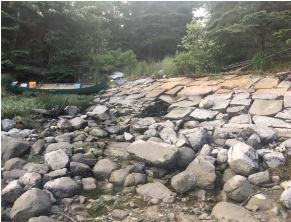Funding Round/Year:
2017
Project Sponsor:
Downeast Salmon Federation
MNRCP Region:
Downeast Maine
Location:
Sullivan
Total Cost of Project:
$167,908
MNRCP Award:
$133,456
Project Type:
Fee Acquisition with Restoration or Enhancement

Project Description:
This project involved the purchase of a parcel at the upper end of Smelt Cove by the Downeast Salmon Federation (DSF). The parcel was part of a subdivision and was on the market for development when DSF purchased it. The parcel has 169 feet of saltwater frontage and approximately 800 feet of Smelt Brook passes through it. The stream drains into a small cove of saltwater mudflats. The property contains a granite dam located within the intertidal zone in Smelt Cove that blocks migratory smelt and brook trout access to Smelt Brook. Smelt Brook historically had a robust run of smelt, but after the construction of the dam, roughly 100 years ago, the run was extirpated. This dam will be removed as part of the project. Removing the dam will begin to return the stream to its natural function, increasing its bio-productivity, biodiversity, and ecological robustnes. Removal will allow fish to pass upstream and will also allow salt water into the impounded area behind the dam, allowing it to revert back to salt marsh. As sea levels rise, the salt marsh will be able to migrate further inland on the property, increasing intertidal wetlands. Freshwater wetlands will form above the salt water. As owner DSF will not trap and remove beaver. Beaver dams will increase the amount of emergent wetlands. The Frenchman Bay Consevancy owns a substantial percentage of the upper Smelt Brook watershed as well as neighboring parcels around adjacent lakes. All of these parcels are managed for conservation and public access. This project will substantially increase the biological functionality of Smelt Brook, and the wetlands and uplands that it drains. The project will also contribute to local biodiversity and ecosystem productivity and resiliency.
